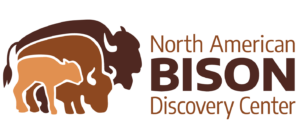Our annual roundup took place on November 16th, 2020. During roundup the animals get an annual wellness check from the veterinarian, which includes necessary vaccinations. On the day of the roundup, we move the bison from the corral, to the sorting tub, and then one at a time to a narrow alley made up of smaller compartments that approach a squeeze chute. During a bison’s turn in the squeeze chute, the animal is vaccinated, and may receive medical tests, like blood draws, semen or pregnancy tests. They are also given identification tags, as well as a once over by the vet.
While the roundup itself only takes one day, we begin preparing for it months prior. One of the ways we prepare is by “cake training” the herds. Because bison are wild animals and we want to reduce the amount of stress they are under, a month or two before the roundup, we start feeding them tasty protein supplements (called range cubes or range cake) several days a week. Once the bison begin associating our vehicle with treats, they learn to follow us. Before long, we only distribute the range cubes in the corral. We want them to associate the corral with positive experiences. A few days prior to the roundup, when all of the bison are eating their treats, we lock them in the corral. The goal is to keep their stress levels low, and complete the roundup in a manner that is safe for both humans and animals. The longer the animals are confined, the higher level of stress they are under, so we work as quickly and as safely possible.
This was an important roundup for us. We needed to destock our herd, as we had more animals than forage. One of our goals is to restore our pasture land, and in order to do that, weneed to be sure we don’t have too many animals for the amount of land to be grazed. We currently have two herds, one on the North side of the interstate and one on the South side. Our North herd now has 1 breeding bull and 7 pregnant cows (we know this because we gave them ultrasound pregnancy tests at roundup, yay!) and our South herd has 1 breeding bull, 3 yearling heifers, and 10 heifer calves. This herd is going to serve as a cultivation herd for us in the future, as we plan to produce replacement heifers for our cow herd in the North, as well as calves for sale.




